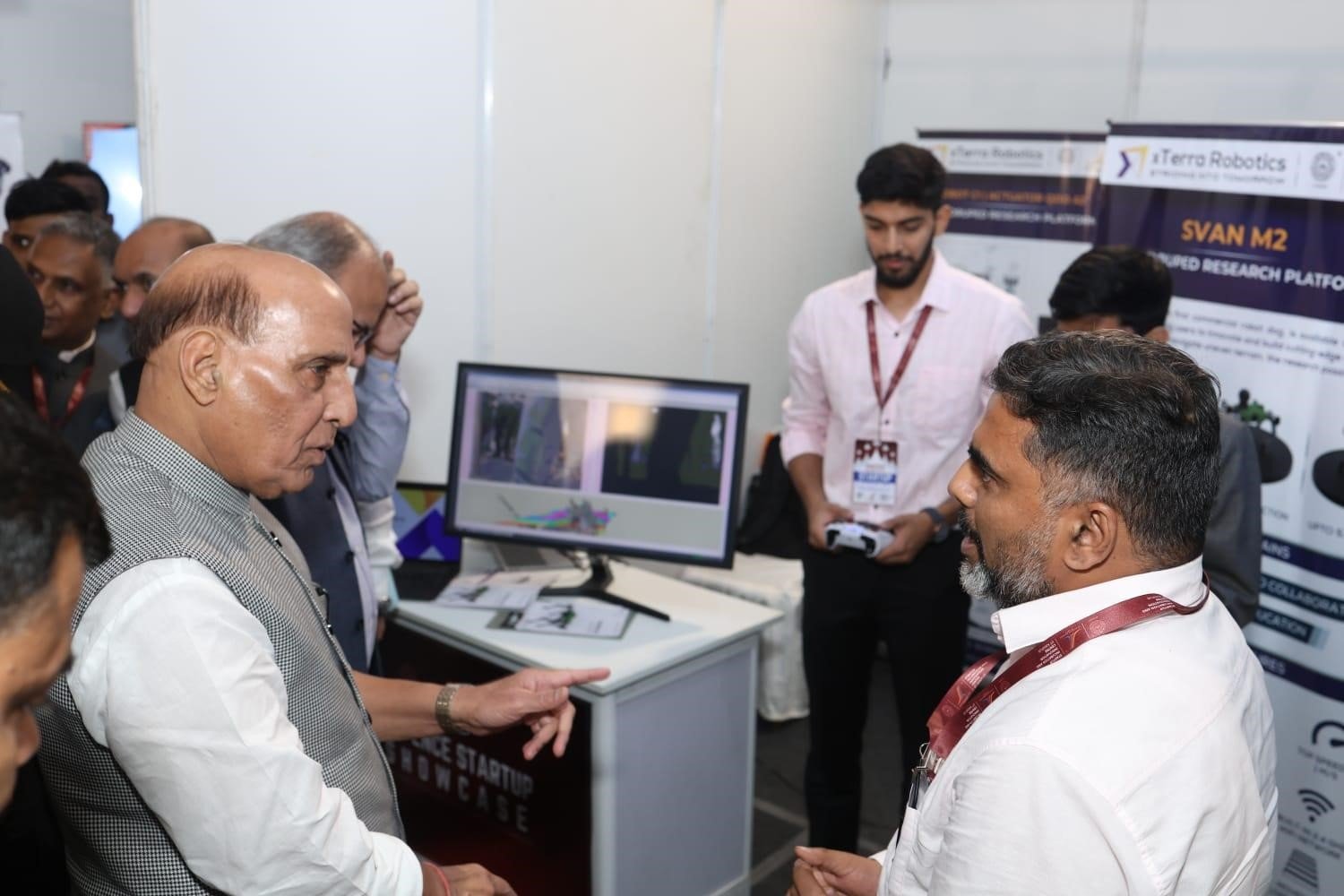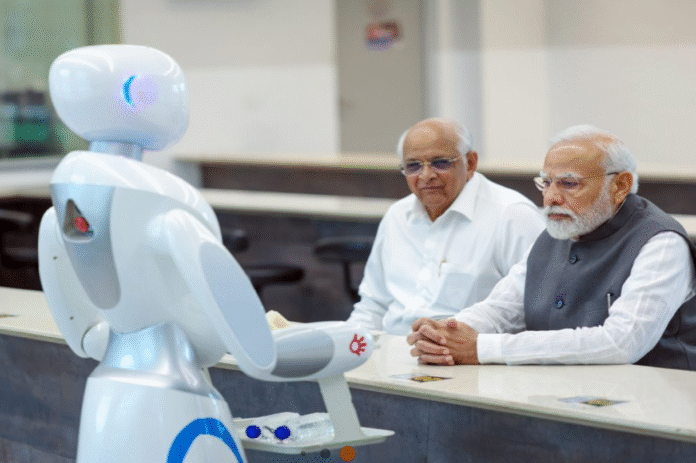India, long seen as a predominantly service-based economy with limited traction in core technology and manufacturing, is now undergoing a profound transformation into an innovation-led, technology-driven powerhouse. This shift has not been accidental; it is the outcome of strategic policy initiatives, a growing culture of entrepreneurship, increased academic involvement, and the government’s push towards Aatmanirbhar Bharat (self-reliant India). Together, these forces are repositioning India on the global map of technological and defence innovation.
At the Startup Mahakumbh held at Bharat Mandapam earlier this year, Prime Minister Narendra Modi highlighted innovation as the cornerstone of India’s ambition for a ‘Viksit Bharat’ (Developed India), stressing that innovation is no longer limited to elite labs or urban hubs but has permeated into India’s grassroots through its thriving startup ecosystem. Startups, he said, are engines of global growth, driving disruption, employment, and scalable impact. He also introduced three transformative national technology missions: The National Quantum Mission, the National AI Mission, and the Semiconductor Mission. These initiatives aim to advance India’s leadership in deep-tech, strengthen domestic supply chains, and create globally relevant solutions. Integrated with the startup ecosystem, these missions reflect a unified national effort to build a world-class innovation economy.
A Paradigm Shift: From Services to Self-Reliance
Over the last two decades, India has undergone a remarkable transformation from the world’s back office for IT and software services to emerging as a global innovation hub, focused on deep technology, product development, and advanced manufacturing. This shift has been fuelled by India’s youthful demographic profile, expanding digital connectivity, and above all, robust policy support that nurtures entrepreneurship and fosters innovation.
A pivotal moment came in 2020 with the launch of Aatmanirbhar Bharat Abhiyan (Self-Reliant India Mission) by Prime Minister Modi, which marked a strategic push to reduce import dependency and build indigenous capabilities in high-impact sectors such as defence, electronics, renewable energy, medical technology, and semiconductors. The initiative brought with it a series of economic reforms, including eased FDI norms, strategic disinvestments, Production-Linked Incentive (PLI) schemes, and streamlined regulations that collectively foster a thriving environment for startups, MSMEs, and large industrial players.
Among the most ambitious undertakings is India’s drive towards semiconductor self-reliance, supported by an unprecedented ₹1.25 lakh crore ($15 billion) investment package under the Semicon India Programme. This initiative aims to establish a robust semiconductor ecosystem, covering chip design, fabrication, assembly, testing, and packaging. The policy offers financial incentives of up to 50% for setting up semiconductor fabs, display manufacturing units, and design infrastructure, along with support for the development of R&D and skilled manpower.

Multiple states, including Gujarat, Tamil Nadu, Karnataka, and Uttar Pradesh, are actively participating in this mission by offering semiconductor-friendly infrastructure, land availability, and policy incentives. Major global players, such as Micron Technology, AMD, Foxconn, and Tata Group, have already announced or initiated multi-billion-dollar semiconductor investments in India, signalling confidence in the country’s long-term vision.
This commitment to building semiconductor sovereignty not only secures India’s position in global electronics supply chains but also supports strategic sectors such as defence, aerospace, 5G, AI, and EVs, where chips are integral. Combined with India’s growing deep-tech startup landscape, this initiative is expected to catalyse next-gen innovation, enhance export potential, and reinforce India’s emergence as a technology powerhouse for the future.
India’s journey towards becoming an innovation powerhouse was accelerated by government initiatives to nurture talent, build infrastructure, and attract investment across key sectors. Startup India Initiative, iDEX, PLI schemes, and Defence Industrial Corridors have been the key pillars of this transformation
Government Initiatives Fuelling Innovation
India’s journey towards becoming a global innovation powerhouse has been significantly accelerated by a series of well-structured government initiatives aimed at nurturing talent, building infrastructure, and attracting investment across key sectors. Among the key pillars of this transformation are flagship schemes such as the Startup India Initiative, iDEX, PLI schemes, and Defence Industrial Corridors, which together form the foundation of India’s self-reliance mission and economic resurgence.
Launched in 2016, the Startup India Initiative marked a paradigm shift in how the Indian government approached entrepreneurship. No longer viewed solely through the lens of traditional business models, innovation and startups were given centre stage as engines of job creation, technology development, and economic diversification. This initiative offered a range of policy enablers designed to reduce entry barriers and catalyse startup growth. Key benefits under this initiative include self-certification under labour and environment laws, thereby reducing regulatory overheads. The creation of the Startup India Hub as a single-point platform for startup registration, support, and funding information further streamlined operations. The government also rolled out the Fund of Funds for Startups (FFS) with a sizeable corpus of ₹10,000 crore, providing financial stability to early-stage ventures through various SEBI-registered venture capital funds.
One of the standout features of India’s startup support framework is the tax holiday for eligible startups, which allows them to claim income tax exemption for any three consecutive years within their first ten years of incorporation. This relief has significantly eased early financial stress for entrepreneurs. Complementing this are initiatives such as the Startup India Seed Fund Scheme (SISFS) and Pradhan Mantri Mudra Yojana (PMMY). While SISFS provides seed funding up to ₹20 lakh (grants) and ₹50 lakh (equity) for early-stage needs like product development and market entry, PMMY offers collateral-free loans to small businesses under its Shishu, Kishor, and Tarun categories. Together, these schemes have catalysed innovation across Tier-II and Tier-III cities. As of 2025, India has over 120,000 registered startups and more than 130 unicorns, establishing itself as the third-largest startup ecosystem globally. These ventures span deep-tech domains including fintech, agritech, edtech, spacetech, and defence, driving India’s self-reliance.
The Innovation for Defence Excellence (iDEX) framework, established under the Defence Innovation Organisation (DIO), was conceived to bridge a critical gap in India’s defence ecosystem, its historical dependence on imports and the lack of nimble, homegrown innovation within traditional procurement models. iDEX offers a transformative approach by empowering startups and MSMEs to directly engage with the Indian Armed Forces, collaboratively developing solutions for mission-critical, real-time operational challenges.

Through flagship initiatives such as the Defence India Startup Challenge (DISC) and the Open Challenge, iDEX has institutionalised a platform for innovators to respond to problem statements identified by the Services. To date, over 350 startups have been onboarded, with many receiving grant-in-aid funding of up to ₹1.5 crore per project. Complementary efforts such as the Technology Development Fund (TDF) and Acing Development of Innovative technologies through Idex (ADITI) scheme further bolster this innovation pipeline, offering financial support of up to ₹5 crore and ₹25 crore respectively.
One of the standout features of India’s startup support framework is the tax holiday for eligible startups, which allows them to claim income tax exemption for any three consecutive years within their first ten years of incorporation. This relief has significantly eased early financial stress for entrepreneurs
The result is a democratised and agile defence innovation ecosystem where entrepreneurs can ideate, prototype, test, and scale technologies in close collaboration with end-users. A wide spectrum of advanced solutions is now being indigenously developed, including autonomous drones, tactical communication platforms, underwater swarm systems, advanced optics, and next-gen wearable tech, each with significant potential for frontline deployment.
Production-Linked Incentive (PLI) Schemes: Building Industrial Strength
A flagship component of India’s drive towards becoming a global manufacturing leader is the PLI (Production-Linked Incentive) scheme. Initially rolled out for the electronics manufacturing sector, PLI now covers 14 critical sectors, including mobile manufacturing, telecom, pharmaceuticals, aerospace, drones, and defence.
These schemes offer performance-based incentives to domestic and foreign manufacturers based on output and investment commitments. For example, the PLI scheme for large-scale electronics manufacturing alone has attracted over ₹1.2 lakh crore in investments, creating both scale and value in supply chains.
In the context of the drones and defence sector, the PLI scheme has led to the emergence of robust local manufacturing capabilities. India, which once relied almost entirely on imported drone components, is now developing complete indigenous drone systems for both civilian and military applications.
Make in India and the Defence Industrial Corridors
The Make in India campaign, launched in 2014, has evolved into a broad-based industrial development strategy. In the defence domain, this has culminated in the creation of two dedicated Defence Industrial Corridors (DICs), in Tamil Nadu and Uttar Pradesh.
These corridors aim to attract investments from both Indian and global defence manufacturers, enhance supply chain linkages, and provide end-to-end infrastructure for R&D, testing, and production. Land banks, testing labs, and skill development centres are integrated into these corridors to ensure seamless operations.
At the heart of India’s innovation ecosystem lies a robust Triple Helix Model, a synergistic collaboration between academia, industry, and the government. Premier institutions such as the IITs, IISc, and NITs are deeply integrated with government-backed programmes and private industry to solve real-world challenges
With Defence Public Sector Undertakings (DPSUs) partnering with private companies and startups, these corridors act as engines of indigenous capability building. Contracts worth thousands of crores have already been signed, covering systems like radars, ammunition, engines, and unmanned systems.
Academia, Industry, and Government: A Triple Helix Model of Collaboration
At the heart of India’s innovation ecosystem lies a robust Triple Helix Model, a synergistic collaboration between academia, industry, and the government. Premier institutions such as the IITs, IISc, and NITs are deeply integrated with government-backed programmes and private industry to solve real-world challenges.

One such initiative is the Technology Development Fund (TDF) administered by the DRDO, which empowers academic institutions to undertake critical design and development tasks aligned with military needs. Additionally, the ARISE program (Applied Research and Innovation for Small Enterprises), under the Atal Innovation Mission, encourages SMEs to work jointly with research institutions, translating lab innovations into field-ready products.
Another game-changer is the Defence Testing Infrastructure Scheme (DTIS), which provides access to state-of-the-art testing facilities for private industry and academic institutions, significantly reducing their go-to-market time.
These efforts have led to the creation of indigenous unmanned ground vehicles (UGVs), AI-based surveillance systems, loitering munitions, and radar systems, underscoring the real-world impact of collaborative R&D.
Bridging the Gaps in India’s Innovation Ecosystem
India’s innovation journey has seen tremendous strides in recent years, with strong government support, an expanding startup ecosystem, and a renewed focus on deep-tech. However, for the country to truly ascend into the league of top global innovation leaders, a few critical challenges must still be addressed.
The rapid evolution of artificial intelligence, cybersecurity, aerospace systems, and advanced materials demands a highly skilled workforce. India must invest in developing deep-tech capabilities through public-private training programmes, innovation fellowships, and international collaborations
Startups and MSMEs often face significant challenges due to complex procurement procedures and bureaucratic red tape. For innovation to thrive, especially in the defence sector, India needs a simplified, transparent, and startup-friendly procurement framework. Accelerating procurement timelines and establishing clear pathways for emerging players to participate in defence contracts will go a long way in fostering innovation. Work on this is already in progress.
One of the key hurdles in tech adoption is the limited willingness among public sector undertakings (PSUs) and the armed forces to pilot or adopt novel solutions from startups. Innovation inherently comes with risks, and institutions must be open to experimentation and iterative development. Creating structured test-bed programs and incentivising early adoption within defence units can encourage risk-taking while supporting indigenous solutions.
To position India as a global defence manufacturing leader, a robust export ecosystem is essential. Currently, fragmented processes and limited global outreach hinder export growth. Streamlining export licensing procedures, fostering bilateral defence agreements, and establishing dedicated export facilitation cells can create a more agile and export-ready ecosystem for Indian defence technologies.
The rapid evolution of technologies, such as artificial intelligence, cybersecurity, aerospace systems, and advanced materials, demands a highly skilled workforce. India must invest in developing deep-tech capabilities through public-private training programmes, innovation fellowships, and international collaborations. Academic institutions, research labs, and industries need to work together to close the talent gap and build a future-ready innovation workforce.

A Future Built on Sovereignty and Innovation
The geopolitical reality of the 21st century, marked by rapidly evolving threats and technological disruptions, necessitates self-reliance in defence and strategic technologies. India’s push for indigenisation is not merely about reducing imports; it is about building sovereign capabilities that can adapt, scale, and respond to national and global challenges.
Schemes like iDEX, Startup India, and PLI are laying the foundation. The increasing integration of academia and industry, particularly in the defence sector, ensures that innovation is not confined to labs but tested, deployed, and battle-ready.
As India moves into its Amrit Kaal (Golden Era), the dream of becoming a technology superpower is no longer aspirational; it is inevitable. With the right mix of vision, execution, and collaboration, India is on track to lead the world in innovation, defence manufacturing, and technological sovereignty.
To position India as a global defence manufacturing hub, a robust export ecosystem is essential. Streamlining export licensing procedures, fostering bilateral defence pacts, and establishing dedicated export facilitation cells can create a more agile and export-ready ecosystem for Indian defence technologies
Conclusion
India’s rise as a technology powerhouse and innovation nation is well underway. What started as scattered policy interventions has become a cohesive national strategy, integrating the best of government planning, academic research, industrial strength and entrepreneurial spirit.
The defence sector, once seen as impenetrable by private players, is now teeming with innovation, enabled by platforms like iDEX and Make in India. With the continued development of defence corridors, the rise of deep-tech startups, and the growing synergy across stakeholders, India is laying the groundwork for a future where it does not just consume technology but leads the world in creating it.
The mission is bold, the pathway is clear, and the momentum is unstoppable. India is not just participating in the fourth industrial revolution; it is helping lead it.
–The writer is an SME and independent consultant in military technology. The views expressed are of the writer and do not necessarily reflect the views of Raksha Anirveda






